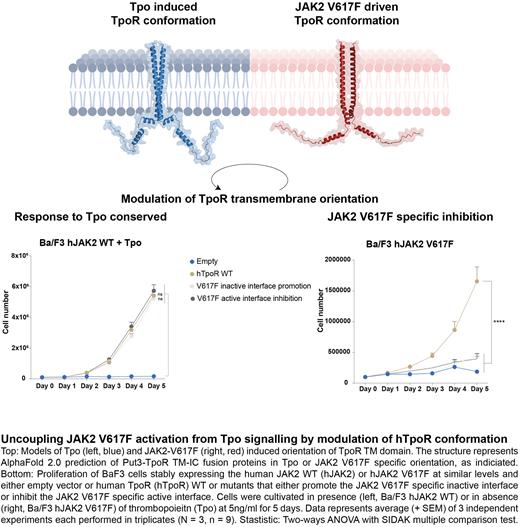Abstract
Myeloproliferative Neoplasms are clonal diseases where mutations in hematopoietic stem cells (HSCs) result in cytokine-independent activation of the Thrombopoietin Receptor (TpoR) and aberrant proliferation and differentiation of HSCs and myeloid progenitors1. The most prevalent mutation, JAK2 V617F, is the basis of >95% of Polycythemia Vera (PV) and 60% of Essential Thrombocythemia (ET) and Myelofibrosis cases2. Current treatment strategies have focused on direct inhibition of JAK2 with little or no success and with poor specificity for the V617F mutant. Unlike JAK2, the TpoR is present at the cell surface and is more easily targetable. Using a system of controlled dimerization, we previously reported that different dimeric orientations of murine TpoR result in distinct signaling pathways and variable activation intensity3. Recently, others have demonstrated that extracellular ligands (diabodies) are able to modulate human TpoR conformation to influence downstream signaling4.
Here, we investigated the possibility to modulate human TpoR conformation to specifically target JAK2 V617F driven activation while preserving natural cytokine-induced signaling. Using our system of controlled dimerization of TpoR transmembrane (TM) domain, we characterized the active and inactive conformation of human TpoR in presence of JAK2 WT or JAK2 V617F in hematopoietic cells. While murine TpoR is active in almost all (6 out of 7) dimeric conformations, only 3 conformations allowed activation of human TpoR. The discrepancy between murine and human TpoR is due to sequence differences in the TM domain that modulates dimerization. Remarkably, we discovered that different dimeric conformations mediate activation of JAK2 WT and JAK2 V617F in human but not in murine TpoR. Using a cysteine cross-linking assay on live cells, we validated that TpoR dimers exhibit a different conformation in presence of JAK2 V617F than this induced by the thrombopoietin (Tpo). Given the different dimeric conformations of TpoR induced by Tpo and JAK2 V617F, we hypothesize that modulation of TpoR conformation could allow specific inhibition of JAK2 V617F-driven activation while preserving Tpo-induced activation. We probed this by introducing a glycine zipper GxxxG motif to favor dimerization in a conformation that renders JAK2 V617F inactive but allows Tpo induced activation. Conversely, we mutated residues of the TM domain to specifically disrupt the conformation required for JAK2 V617F-mediated activation. Both strategies resulted in complete inactivation of JAK2-V617F driven activation of TpoR but preserved its full activation by Tpo and cell surface localization.
Together, these results provide a first demonstration that modulation of TpoR dimeric conformation is a suitable strategy for specific inhibition of the JAK2 V617F-driven activation and opens the road for novel therapeutic avenues.
1. Vainchenker W, Kralovics R. Genetic basis and molecular pathophysiology of classical myeloproliferative neoplasms. Blood. 2017;129(6):667-679.
2. Constantinescu SN, Vainchenker W, Levy G, Papadopoulos N. Functional Consequences of Mutations in Myeloproliferative Neoplasms. Hemasphere. 2021;5(6):e578.
3. Staerk J, Defour JP, Pecquet C, et al. Orientation-specific signalling by thrombopoietin receptor dimers. Embo j. 2011;30(21):4398-4413.
4. Cui L, Moraga I, Lerbs T, et al. Tuning MPL signaling to influence hematopoietic stem cell differentiation and inhibit essential thrombocythemia progenitors. Proceedings of the National Academy of Sciences. 2021;118(2):e2017849118.
Disclosures
Constantinescu:MyeloPro Research and Diagnostics GmbH, Vienna, Austria: Current Employment, Other: Co-founder.
Author notes
Asterisk with author names denotes non-ASH members.


This feature is available to Subscribers Only
Sign In or Create an Account Close Modal